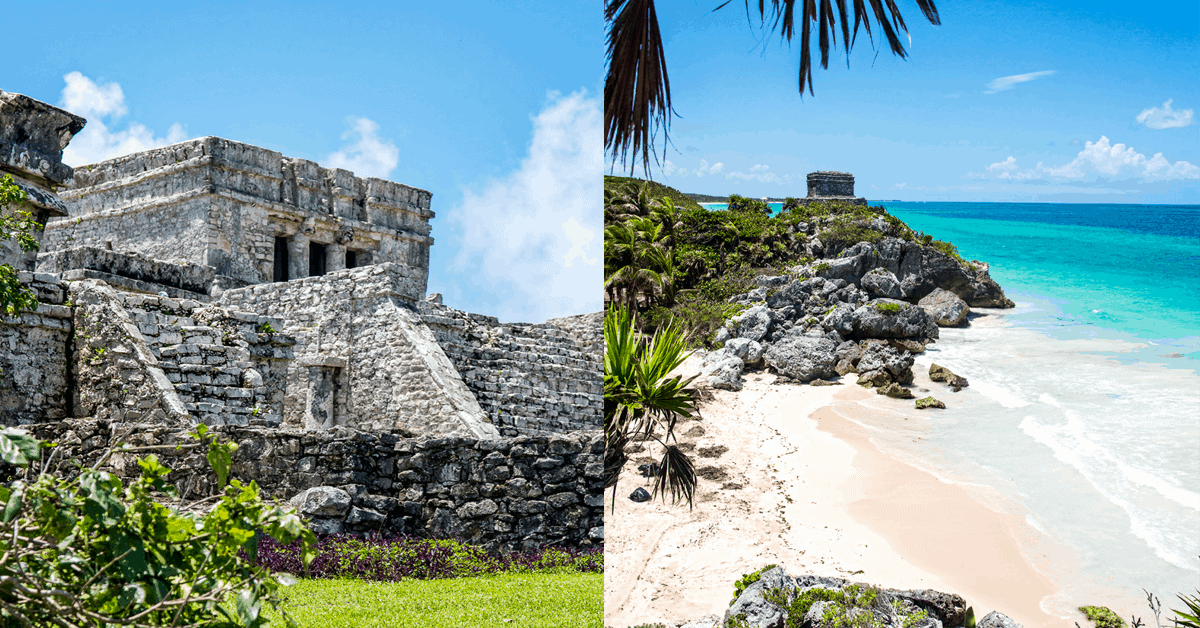Tulum Ruins – Where You Can Enjoy a White Sand Beach, Breathtaking Views & Mayan History

Tulum Ruins Day Trip
On our recent trip to Mexico, Peter and I were able to witness the spectacular Tulum Ruins located at the western end of the Caribbean coast. From Cancun it’s 80 miles/130 km, and it’s an easy drive from Playa del Carmen (40 miles/65 km). We chose to rent a car and enjoy a drive down the coast to the walled site at Tulum National Park, although buses and both groups and private tours are plentiful and easy to find in either town or through your hotel concierge.
Tulum is divided into four areas: the archaeological site, the town, the hotel zone, and Sian Ka’an, a biosphere reserve. The archaeological site, known as Tulum Ruins, were built on a bluff in the 13th century and is the only Mayan settlement ever located on the Caribbean coast. It is now the third most visited archeological site in Mexico and received thousands of visitors every day.
Driving into the site, we found that Tulum Ruins has its own parking lot, which we used for a mere 50 pesos. Before entering the path to the site, it’s good to stop at the small information booth where the staff explains the layout of the ruins and directs you to the entrance. (Note: You may be accosted by tour operators plying their trade, here or in the parking lot. While you have the option of paying for a guided tour, we preferred taking it all in at a leisurely pace and opted out.)
We walked down a long road lined with trees to reach the entrance. (You can also take a little family run tram for a small fee, but what’s the fun in that?) A short line brought us to the ticket office where we paid our entrance fee (approximately $35-65 pesos/$3.50). Then we were free to enjoy the Tulum Ruins at our own speed.
Tulum Ruins Day Trip TIP: Make sure you bring pesos with you for parking, entrance fee, and any purchases on site. They do not accept dollars or any type of plastic.
Tulum Mayan Ruins History
The site itself is breathtaking, starting with El Castillo resting high up on the cliff top overlooking the gorgeous blue waters. This 75-foot high pyramid was the watchtower, lighthouse, and served as the first line of defense against water invasion. In order to preserve the building, visitors are no longer allowed inside to see the beautiful carved serpents or look out the upper windows at the ocean. We were bummed but understand why everything is not blocked off. That ocean brought together maritime traders from neighboring towns and nations and inland/highland peoples, making Tulum a busy trading center in its heyday. Once quite a populous site, its demise was brought about by diseases imported by the Spanish conquistadors. Abandoned, it fell to ruin until rediscovered in 1840.
The settlement itself is surrounded by limestone walls on three sides (with no fourth wall needed due to its beachfront location). Within those walls are two major structures, along with the partial remains of quite a few others (which are worth exploring).
The two-story Temple of the Frescoes was used as an observatory and contains a culturally significant 3-panel mural. You won’t be able to go inside and see the mural for yourself, but take the time to read the history behind it. Fascinating…
Then there is the Temple of the Descending God, which gets its name from the carving that graces the façade of the temple. Mayan gods were thought to reside only in the heavens, so the fact that one is “diving” down is curious. Not as curious, given the Mayans obsessions with calendars and dates, is the fact that the temple was built in alignment with the morning star, Venus, and the sun. During the vernal (spring) equinox, this allows the sunlight to shine into the temple and illuminate the descending god.
We spent a fair amount of time walking around the partial ruins, guessing what the different outcroppings might have been in their day, and also had some fun taking photos of the large population of iguanas that have taken over the Tulum Ruins.
Tulum Ruins Day Trip TIP: It’s hot and sunny year round here, with temperatures ranging in the 80s from October to April and in the 90s the rest of the year. Bring plenty of sunscreen, water, and a stylish hat!
Tulum Ruins Beach
Once we had toured the grounds and seen the glory of Mayan architecture, we wandered down the wooden staircase that clung to the cliffside and landed on the Tulum Ruins Beach, where there were colors unlike any we’d seen before. It was utterly gorgeous and may have been my favorite in all my travels in Mexico. We chose to stay awhile and cool off in those vivid blue Caribbean waters and suggest you do the same. (Remember to pack a bathing suit and towel!) There is a restroom at the entrance of Tulum Ruins if you need to change into your swimsuit. There is nowhere to change once you’re at the beach so make sure you’re already wearing it, or you’re prepared to change behind a towel.
You can also walk up and down the beach and, depending on the tide, might be able to find some nooks and caves carved out of the cliffs to explore.
Tulum Boca Paila Road
When you’re done for the day, you can head to Tulum Boca Paila Road and find a place to eat. We had an excellent meal at Mateo’s Mexican Grill, but you’ll have a lot to choose from. You can also go into Tulum proper to eat, which is about 4 km (2.5 miles) from the ruins. You’ll also find accommodations here and down the road in the hotel zone. But know that buses do not run to the hotel zone, only private cars, and taxis. Accommodations run from barely habitable beach huts to high-end luxury resorts, with just about everything in between. So no matter your budget, you’ll find a place.
Sian Ka’an
And if you do stay the night, think about heading over to the Sian Ka’an Biosphere reserve the next day. A UNESCO World Heritage Site, Sian Ka’an is the result of the efforts of governments, scientists, farmers and fisherman, and locals to conserve natural resources, from coral reefs to coastal wetland, plant and animal life, as well as archaeologically and culturally significant ruins. You can take small personalized or private tours and see some spectacular wildlife and scenery while being environmentally conscious at the same time.
Tulum Ruins
Tulum, Quintana Roo, Mexico
Phone: +52 983 837 0796
Open daily: 8 am to 5 pm
Entrance Fee: 65 pesos ($3.50 US), parking 50 pesos ($2.75 US)
Stay Stylish,
-V






